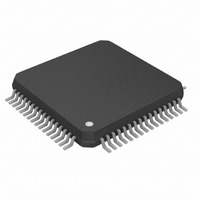MAX5632UCB+D Maxim Integrated Products, MAX5632UCB+D Datasheet - Page 12

MAX5632UCB+D
Manufacturer Part Number
MAX5632UCB+D
Description
IC DAC 16BIT 32CH S&H 64-TQFP
Manufacturer
Maxim Integrated Products
Datasheet
1.MAX5633UCBD.pdf
(16 pages)
Specifications of MAX5632UCB+D
Number Of Bits
16
Data Interface
Serial
Number Of Converters
32
Voltage Supply Source
Dual ±
Operating Temperature
0°C ~ 85°C
Mounting Type
Surface Mount
Package / Case
64-LQFP
Lead Free Status / RoHS Status
Lead free / RoHS Compliant
Power Dissipation (max)
-
Settling Time
-
The operating modes can also be selected externally
through CLKSEL and IMMED. In the case where the
control bit in the serial word and the external signal
conflict, the signal that is a logic “1” is dominant.
The MAX5631/MAX5632/MAX5633 feature three modes
of operation:
1) Sequence Mode
2) Immediate Update Mode
3) Burst Mode
Sequence mode is the default operating mode. The
internal sequencer continuously scrolls through the
SRAM, updating each of the 32 SHAs. At each SRAM
address location, the stored 16-bit DAC code is loaded
to the DAC. Once settled, the DAC output is acquired
by the corresponding SHA. Using the internal
sequencer clock, the process typically takes 320µs to
update all 32 SHAs (10µs per channel). Using an exter-
nal sequencer clock the update process takes 128
clock cycles (four clock cycles per channel).
Immediate update mode is used to change the con-
tents of a single SRAM location, and update the corre-
sponding SHA output. In Immediate Update Mode, the
16-Bit DACs with 32-Channel
Sample-and-Hold Outputs
Table 3. Update Mode
Figure 5. Immediate Update Mode Timing Example
12
SHA ARRAY
UPDATE
SEQUENCE
Immediate Update Mode
______________________________________________________________________________________
CS
UPDATE MODE
Burst Mode
1
DIN
LOAD ADDRESS 20
2
3
1/f
SEQ
7
CHANNEL 20
UPDATED
24-BIT
WORD
Immediate Update Mode
SKIP
Modes of Operation
20
UPDATE TIME
Sequence Mode
7
33/f
2/f
CHANNEL REFRESHED
SEQ
INTERRUPTED
SEQ
8
9
selected output is updated before the sequencer
resumes operation. Select Immediate Update Mode by
driving either IMMED or C1 high.
The sequencer is interrupted when CS is taken low. The
input word is then stored in the proper SRAM address.
The DAC conversion and SHA sample in progress are
completed transparent to the serial bus activity. The
SRAM location of the addressed channel is then modi-
fied with the new data. The DAC and SHA are updated
with the new voltage. The sequencer then resumes
scrolling at the interrupted SRAM address.
This operation can take up to two cycles of the 10µs
sequencer clock. Up to one cycle is needed to allow the
sequencer to complete the operation in progress before
it is freed to update the new channel. An additional
cycle is required to read the new data from memory,
update the DAC, and strobe the sample-and-hold. The
sequencer resumes scrolling from the location at which
it was interrupted. Normal sequencing is suppressed
while loading data, thus preventing other channels from
being refreshed. Under conditions of extremely frequent
Immediate Updates (i.e., 1000 successive updates), this
can result in unacceptable droop.
Figure 5 shows an example of an immediate update
operation. In this example, data for channel 20 is
loaded while channel 7 is being refreshed. The
sequencer operation is interrupted, and no other chan-
nels are refreshed as long as CS is held low. Once CS
returns high, and the remainder of an f
any) has expired, channel 20 is updated to the new
data. Once channel 20 has been updated, the
Figure 6. Burst Mode Timing Example
SEQUENCE
SHA ARRAY
UPDATE
DIN
CS
6
7
SKIP
1/f
SKIP
SEQ
SKIP
LOAD MULTIPLE
ADDRESSES
7
33 CYCLES TO UPDATE
ALL CHANNELS
8
SEQ
5
6
period (if
7







